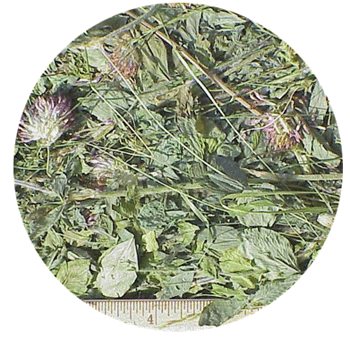Feedstuff/Equipment Discovery: Feedstuffs
Feedstuff/Equipment Discovery: Feedstuffs
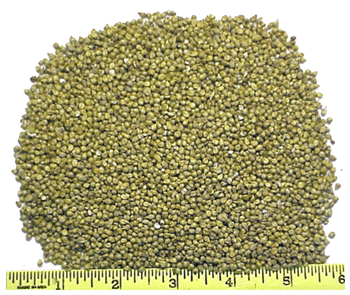
Feedstuff & Equipment Discovery Navigation
Cereal Grains & Processed Cereal Grains
- Not widely grown in U.S.
- Compared to corn, it contains less energy and more protein.
- Except when fed to poultry, it is typically ground or rolled prior to feeding.
- Bul density = 50 lbs/bushel
Average Nutrient Content
- Ruminant TDN = 90%
- Monogastric ME = 1300 Kcal/lb
- Crude Protein = 12.5%
Physical Description - brown color, small and round or slightly oblong shape, and a smooth texture.
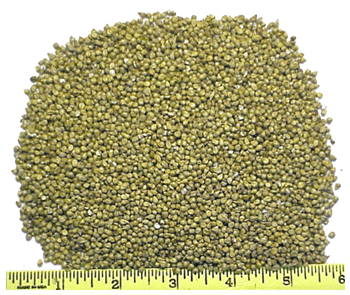
- Grown primarily in dry regions of U.S., where there is not enough rain for corn production.
- Compared to corn in feeding value.
- Due to very hard seed coat, it is usually processed prior to feeding (coarsely ground, rolled, crimped, etc.).
- Bulk density = 55 lbs/bush
- Average Nutrient Content
- Ruminant TDN = 82%
- Monogastric ME = 1520 Kcal/lb
- Crude Protein = 10%
Physical Description - reddish-brown color, round and bead-like shape, and a smooth texture.
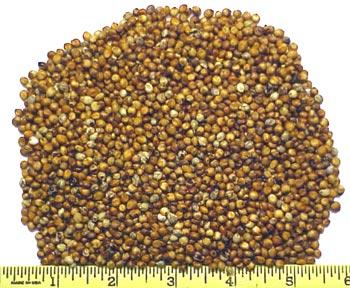
- Not a very important feed grain in the U.S.
- Lower palatability than most other cereal grains.
- Compared to corn, it is slightly lower in energy and higher in protein.
- Except when fed to sheep, it should be processed prior to feeding (ground, cracked, etc.).
- Bulk density = 56 lbs/bushel
Average Nutrient Content
- Ruminant TDN = 88%
- Monogastric ME = 1375 Kcal/lb
- Crude Protein = 12.5%
Physical Desciption - brownish-gray coor, long an full shape, round edges, and a smooth texture.
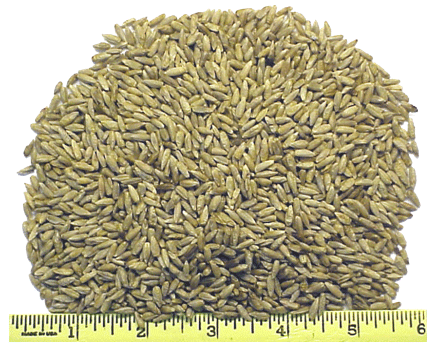
- Not widely grown in the U.S.
- A synthestic cereal grain, derived by crossing what with rye.
- Compared to corn, it is slightly lower in energy and higher in protein.
- Usually processed in some way prior to feeding (coarsely ground, cracked, etc.).
- Bulk density = 56 lbs/bushel
Average Nutrient Content
- Ruminant TDN = 90%
- Monogastric ME = 1425 Kcal/lb
- Crude Protein = 14%
Physical Description - brown color, short and oblong shape (plumper than wheat), round edges, crease down middle of one side, and a smooth texture.
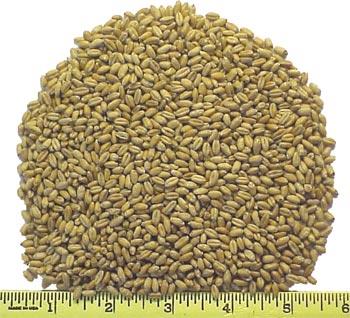
- Widely grown in the U.S.
- Primarily used in human food, but can be fed to livestock.
- Compared to corn, it is slightly lower in energy and higher in protein.
- Usually processed in some way prior to feeding (coarsely ground, rolled, cracked, etc.).
- Bulk density = 60 lbs/bushel
Average Nutrient Content
- Ruminant TDN = 88%
- Monogastric ME = 1450 Kcal/lb
- Crude Protein = 13.5%
Physical Description - brown color, short and oblong shape, round edges, crease down middle of one side, and smooth texture
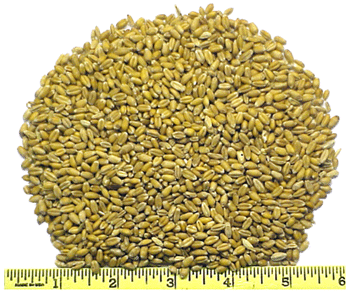
- Most extensively produced feed grain in U.S.
- Typically the energy standard to which other grains are compared.
- High energy content, but low in protein.
- Low fiber content.
- Usually processed in some way prior to feeding (ground, cracked, steam-flaked, etc.).
- Bulk density = 56 lbs/bushel
Average Nutrient Content
- Ruminant TDN = 90%
- Monogastric ME = 1550 Kcal/lb
- Crude Protein = 8.5%
Physical Description - yellow color, somewhat tear-shaped, and a smooth texture.
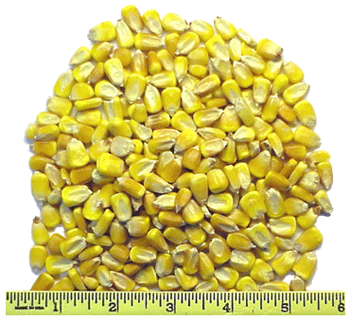
- Shelled corn that has been mechanically processed through a hammer mill.
- Reduces the particle size, increases surface area, and improves energy utilization.
- Actual particle size of ground corn will depend on screen size and power of the hammer mill.
- Coarser grinds are preferred for ruminants, and finder grinds are generally preferred for monogastrics.
Average Nutrient Content
- Ruminant TDN = 90%
- Monogastric ME = 1550 Kcal/lb
- Crude Protein = 8.5%
Physical Description - yellow and white color, fine to coarse particle size, and a granular to powdery texture.
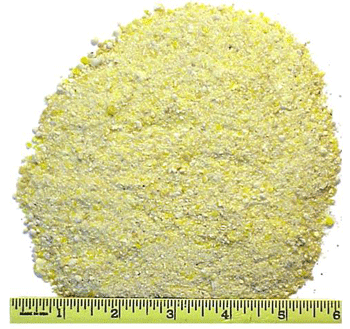
- Shelled corn that has been mechanically processed through a hammer mill.
- Reduces the particle size, increases surface area, and improves energy utilization.
- Actual particle size of ground corn will depend on screen size and power of the hammer mill.
- Coarser grinds are preferred for ruminants, and finer grinds are generally preferred for monogastrics.
Average Nutrient Content
- Ruminant TDN = 90%
- Monogastric ME = 1550 Kcal/lb
- Crude Protein = 8.5%
Physical Description - yellow and white color, fine to coarse particle size, and a granular to powdery texture.
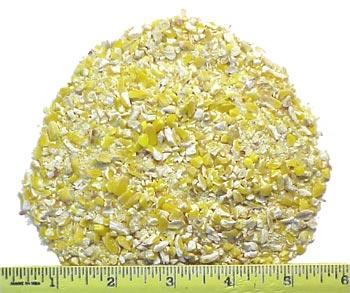
- The entire ear of corn (grain and cob) that has been ground through a hammer mil or burr mill.
- Reduces particle size, increases the surface area, and improves starch digestibility.
- Due to high fiber content, it is fed primarily to rumant animals
Average Nutrient Content
- Ruminant TDN = 78%
- Monogastric ME = 1400 Kcal/lb
- Crude Protein = 8.0%
Physical Description - white and yellow color, various particle sizes, and a rough texture.
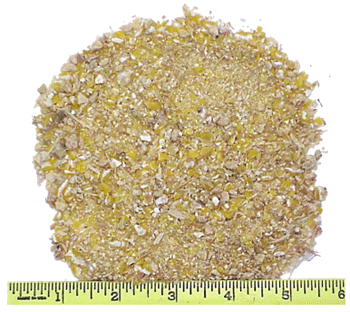
- helled corn that is subject to high-moisture steam for a long period of time (15-30 minutes) and then rolled to produce a flat flake.
- Increases the surface area and gelatinizes some of the starch making it more digestible.
- Primarily fed to cattle and horses
Average Nutrient Content
- Ruminant TDN = 90%
- Monogastric ME = 1550 Kcal/lb
- Crude Protein = 8.5%
Physical Description - yellow and white color, flat shape, and a flaky texture.
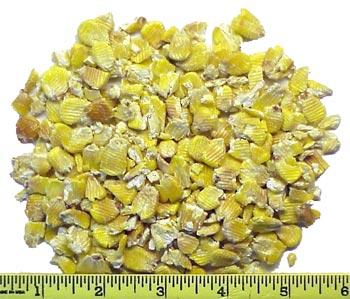
- Not as widely available in west U.S. as corn, wheat, and oats.
- Compared to corn, it contains less energy but has more protein, lysine, and fiber.
- Usually processed in some way prior to feeding (coarsely ground, steam-rolled, crimped, etc.).
- Bulk density = 48 lbs/bushel
Average Nutrient Content
- Ruminant TDN = 88%
- Monogastric ME = 1320 Kcal/lb
- Crude Protein = 12.5%
Physical Description - brown color, oblong shape, irregular edges, and a slightly rough texture.
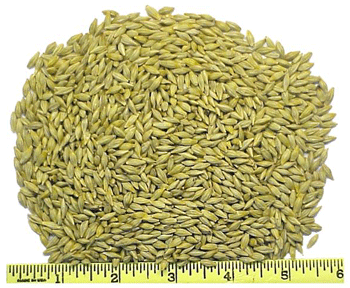
- Whole barley that is subjected to high-moisture steam for a short period of time (1-8 minutes) and then rolled to produce a flat flake.
- Increases the surface area and improves energy utilization.
- Used primarily in horse diets and feedlot diets.
Average Nutrient Content
- Ruminant TDN = 88%
- Monogastric ME = 1320 Kcal/lb
- Crude Protein = 12.5%
Physical Description - brown color, flat shape, and a flaky texture.
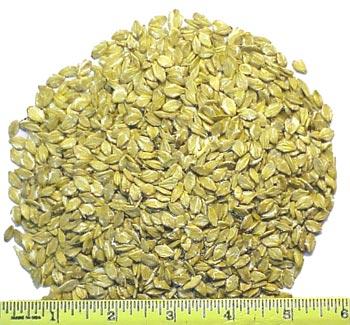
- Widely grown in cool, moist climates of the U.S.
- Compared to corn, it is lower in energy and higher in protein.
- Used extensively in horse feeds and feeds for starting young animals.
- Can be fed whole, but usually processed prior to feeding (rolled, ground, crushed, crimped, steamed, etc.).
- Bulk density = 32 lbs/bushel
Average Nutrient Content
- Ruminant TDN = 77%
- Monogastric ME = 1200 Kcal/lb
- Crude Protein = 12%
Physical Description - light brown color, long and thin shape, and a slightly rought texture with irregular edges.
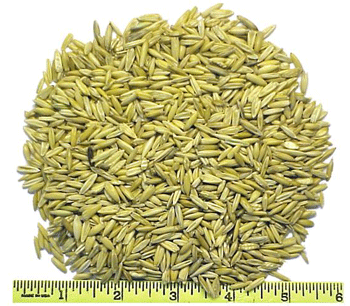
- Whole oats that have been passed between a set of closely fitted, corrugated rollers to produce a flake.
- Increases the surface area and improves energy utilization.
- Used primarily in horse diets or diets for young animals.
Average Nutrient Content
- Ruminant TDN = 77%
- Monogastic ME = 1200 Kcal/lb
- Crude Protein = 12%
Physical Description - light brown color, long flat shape, and a flaky texture.
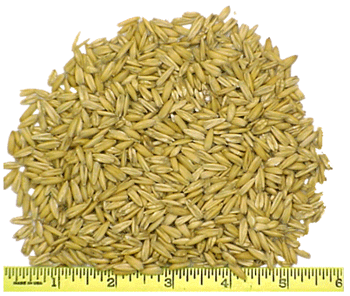
- Whole oats that are subjected to high-moisture steam for a short period of time (1-8 minutes) and then rolled to produce a flat flake.
- Increases the surface area and improves energy utilization.
- Used primarily in horse diets or diets of young animals.
Average Nutrient Content
- Ruminant TDN = 77%
- Monogastric ME = 1200 Kcal/lb
- Crude Protein = 12%
Physical Description - light color, flat shape, and a flaky texture.
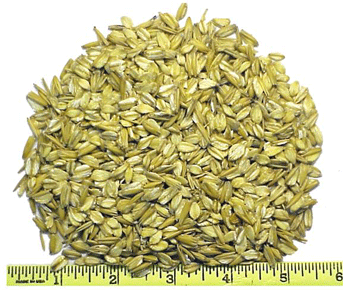
.
Protein Sources of Plant Origin
- Excellent feedstuff for horses and ruminants (high in protein, minerals, and vitamins).
- Lower fiber content than traditional alfalfa hay.
- Limited use in monogastric diets (sometimes used as a laxative in prefarrowing sow diets).
- Often pelleted prior to feeding.
Average Nutrient Content
- Crude Protein = 17-20%
- Lysine = 0.7-0.9%
- Ruminant TDN = 57%
- Monogastric ME = 1000 Kcal/lb
Physical Description - varies from light to dark green, small particle size, and a granulary to powdery texture.
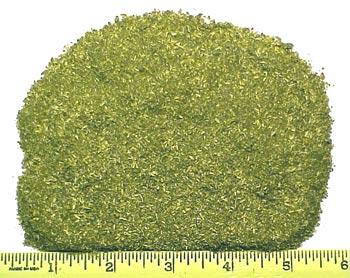
- Widely grown in the U.S.
- Rarely fed in the whole, full-fat form, but can be if first heated to destroy anti-nutritional factors (trypsin inhibitor).
- Can be a valuable source of protein and energy.
- Usually processed (oil removed and ground) into soybean meal for livestock feeding.
Averate Nutrient Content
- Crude Protein = 35-38%
- Lysine - 2.2=2.4%
- Ruminant TDN = 85%
- Monogastric ME = 1600 Kcal/lb
Physical Description - light brown color with a black "eye", fairly round shape, and a smooth texture.
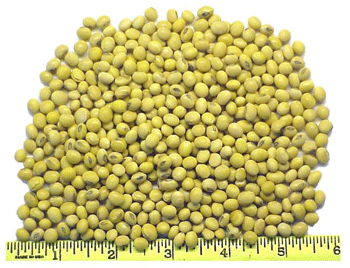
- Most widely used protein supplement in the U.S.
- Produced by grinding the flakes that remain after oil is extracted from whole soybean.
- Very palatable with the highest nutritional value of any plant protein source.
- Excellent source of protein and amino acids.
Average Nutrient Content
- Crude Protein = 44-48%
- Lysine = 2.8-3.0%
- Ruminant TDN = 78%
- Monogastric ME = 1400 Kcal/lb
Physical Description - light borwn color, irregular shape, and a granular to flaky texture.
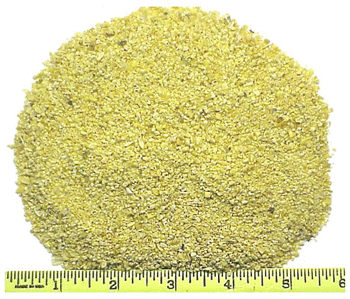
- Widely grown in the southern U.S.
- Used as a feed source for dairy and beef cattle, and does not require processing prior to feeding.
- Not used in monogastric feeds due to toxicity problems associated with gossypol (a yellow pigment).
- High in protein, energy, and fiber.
Average Nutrient Content
- Crude Protein = 23%
- Lysine = 1.0%
- Ruminant TDN = 96%
- Monogastric ME = N/A
Physical Description - white color, roundish oblong shape, and a fuzzy texture.
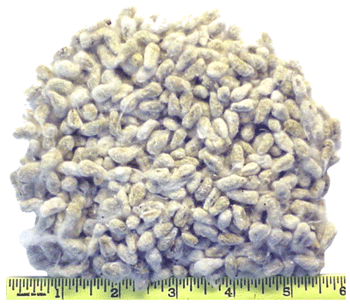
- Widely grown in the southern U.S.
- Produced by grinding the flakes that remain after oil is extracted from whole cottonseeds.
- Excellent protein source for ruminants, but only limited use in monogastrics (gossypol toxicity).
- Low in lysine and tryptophan.
Average Nutrient Content
- Crude Protein = 38-41%
- Lysine = 1.5-1.7%
- Ruminant TDN = 71%
- Monogastric ME = 1200
Physical Description - brown color with black flecks, and a granular to powdery texture.
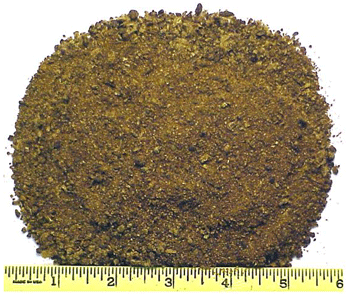
- Grown primarily in cooler climates where other oil seeds cannot be grown.
- Produced by grinding the flakes that remain after oil is extracted from whole canola seeds.
- Canola is a crop derived from rapeseed, but unlike traditional rapeseed is low in both erucic acid and glucosinates.
- Lower in digestible energy than soybean meal.
Average Nutrient Content
- Crude Protein = 35-38%
- Lysine - 2.0-2.3%
- Ruminant TDN = 64%
- Monogastric ME = 1100 Kcal/lb
Physical Description - yellowish brown to brown color, small particle size, and a granular to powdery texture.
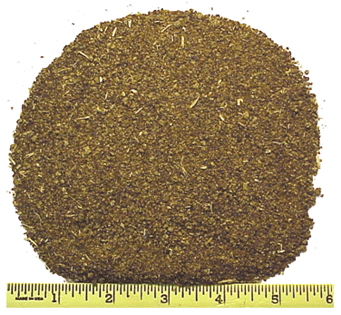
- Grown primarily in north-central U.S.
- Produced by grinding the flakes that remain after oil is extracted from whole flaxseed.
- Used primarily in diets for ruminants and horses, with limited use in monogastric diets due to poor amino acid distribution.
- Has a laxative effect.
Average Nutrient Content
- Crude Protein = 32-35%
- Lysine = 1.0-1.2%
- Ruminant TDN = 73%
- Monogastric ME = 900 Kcal/lb
Physical Description - varies from light to dark brown color, small particle size, and a granular texture.
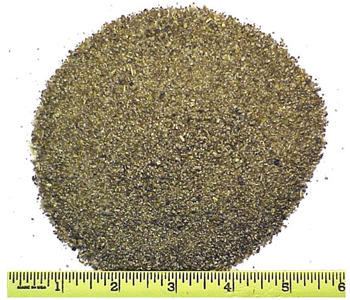
- Produced by grinding the oil extracted peanut kernels.
- Highly palatable and high in protein.
- Protein is somewhat low in digestibility due to tannins found in the skin, and has poor amino acid balance.
- Somewhat susceptible to aflatoxin contamination.
Average Nutrient Content
- Crude Protein = 45-48%
- Lysine = 1.5-1.8%
- Ruminant TDN = 73%
- Monogastric ME = 1250 Kcal/lb
Physical Description - light brown to brown color, and a granular to powdery texture.
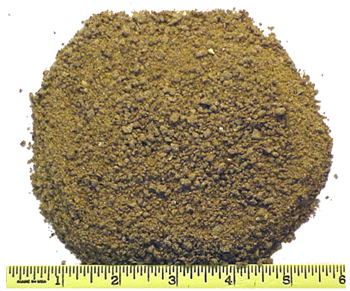
- Produced by grinding the oil extracted sunflower seeds.
- High in protein, but low in the amino acid lysine.
- High fiber content (11-13%) limits its use in monogastric diets.
Average Nutrient Content
- Crude Protein = 34-41%
- Lysine = 1.4-2.0%
- Ruminant TDN = 61%
- Monogastric ME = 1125 Kcal/lb
Physical Description - brown to brownish-black color with light gray flecks, small particle size, and granular to powdery texture.
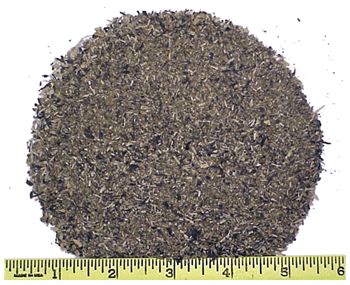
Protein Sources of Animal Origin
- By-product of the meat packing industry that is produced by grinding dried blood into a meal.
- Very high in protein, but low in the amino acid isoleucine.
- Lower in palatability and digestibility than many other protein sources.
- Good source of ruminant bypass protein, and used in limited amounts in young pig diets.
Average Nutrient Content
- Crude Protein = 80%
- Lysine = 7.0%
- Ruminant TDN = 60%
- Monogastric ME = 900 Kcal/lb
Physical Description - dark brown to dull red color and a granular to powdery texture.
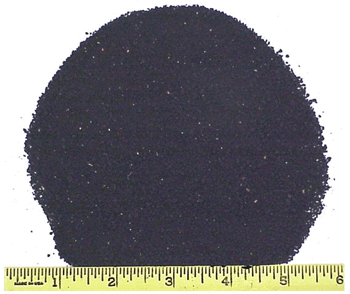
- Produced by drying milk after the fat has been removed.
- Good source of digestible protein, but usually deficient in fat soluble vitamins and some minerals.
- High cost limits widespread use.
- Primarily used in milk replaceers and starter diets for young animals.
Average Nutrient Content
- Crude Protein = 33%
- Lysine = 2.6%
- Ruminant TDN = 80%
- Monogastric ME = 1500 Kcal/lb
Physical Description - creamy to light tan color and a powdery texture.
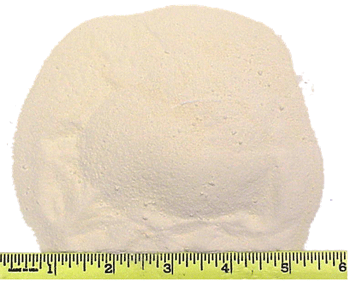
- By-product from making cheese that is produced by spray-drying the liquid that remains after the casein and most of the fat has been removed.
- Good source of digestible protein and energy (high in lactose).
- High cost limits its widespread use.
- Primarily used in diets for newly weaned pigs to increase feed intake.
Average Nutrient Content
- Crude Protein = 12%
- Lysine = 1.1%
- Ruminant TDN = 79%
- Monogastric ME = 1450 Kcal/lb
Physical Description - creamy to light brown color and a powdery texture.
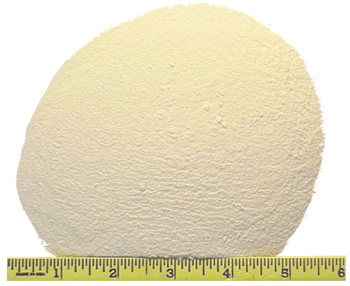
- By-product from making cheese that is produced by roller-drying the liquid that remains after the casein and most of the fat has been removed.
- Good source of digestible protein and energy (high in lactose).
- High cost limits its widespread use.
- Primarily used in diets for newly weaned pigs to increase feed intake.
Average Nutrient Content
- Crude Protein = 12%
- Lysine = 1.1%
- Ruminant TDN = 79%
- Monogastric ME = 1450 Kcal/lb
Physical Description - tan to light brown color, and a granular to powdery texture.
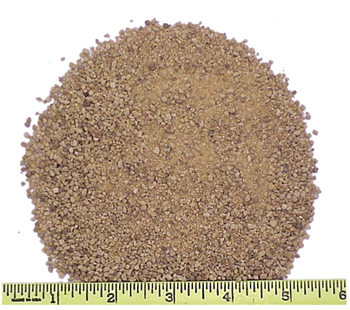
- By-product from poultry slaughtering industry that is produced by grinding the cleaned, dried, and hydrolyzed feathers.
- Very high in protein, but very low in most other nutrients.
- Palatability can be a problem.
- Primarily used in diets for mature ruminants, and will rarely exceed more than 5% of the diets for monogastrics.
Average Nutrient Content
- Crude Protein = 85%
- Lysine = 1.0%
- Ruminant TDN = 63%
- Monogastric ME = 1050 Kcal/lb
Physical Description - brown color with flecks of white and a granular to powdery texture.
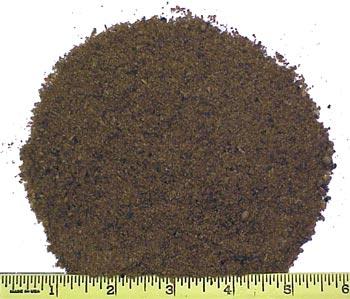
- Fishery industry by-product, produced by grinding the cleaned, dried tissue of fish cuttings, with or without extraction of the oil.
- Excellent source of digestible protein, B vitamins, and minerals.
- Used extensively in poultry diets, but also used in weanling pig diets and in rumen bypass feeds.
- Palatability can be a problem.
Average Nutrient Content
- Crude Protein = 60%
- Lysine = 4.7%
- Ruminant TDN = 71%
- Monogastric ME = 1460 Kcal/lb
Physical Description - brown color with tiny white bone chips and a powdery texture.
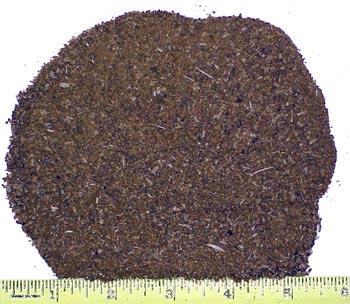
- Rendering industry by-product, produced by grinding the dried mammalian tissue (excludes blood, hair, hoof, horn, hide trimmings, stomach, and rumen).
- Good source of protein, energy, calcium, and phosphorus.
- Primarily used as a partial source of supplemental protein for monogastrics (limited use in ruminant and horse diets).
- Low palpability (hard to handle).
Average Nutrient Content
- Crude Protein = 45-50%
- Lysine = 2.2-2.6%
- Ruminant TDN = 67%
- Monogastric ME = 1150 Kcal/lb
Physical Description - light brown color with tiny white bone chips and a powdery texture.
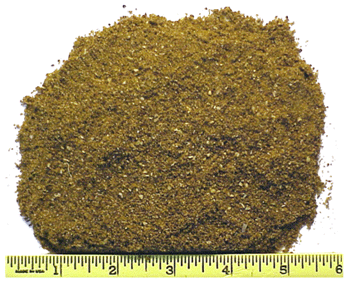
- Meat packing industry by-product, produced by adding anticoagulant to freshly collected blood, separating the plasma from the red blood cells by centrifugation, and spray-drying the plasma
- High in protein, and contains active immunoglobulins.
- Primarily used as a protein source for early weaned pigs.
- High cost limits its use.
Average Nutrient Content
- Crude Protein = 78%
- Lysine = 6.8%
- Ruminant TDN = N/A
- Monogastirc ME = N/A
Physical Description - off white to tan color and a fine powdery texture.
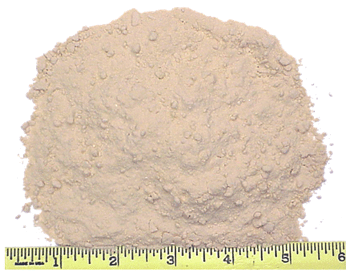
Cereal Grain By-Products
- By-product of the beer making industry.
- Consists of the dried extracted residue of barley malt (alone or in mixtures with other grains) that have been used to provide maltose and dextrins for fermenting.
- Primarily used as a ruminant feed, but may be fed in limited amounts to monogastrics.
Average Nutrient Content
- Ruminant TDN = 73%
- Monogastric ME = 900 Kcal/lb
- Crude Fiber = 12%
- Crude Protein = 27%
Physical Description - brown color, oblong particles, and a flaky texture.
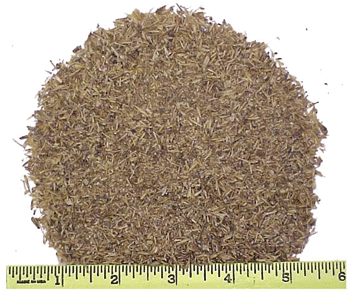
- Consists of the outer covering of oat grain after it has been processed to separate the groat (kernel) from the hull.
- A source of fiber that is low in energy and protein.
- Primarily used as a ruminant roughage extender during times when forages are in short supply.
Average Nutrient Content
- Ruminant TDN = 37%
- Monogastric ME = 300 Kcal/lb
- Crude Fiber = 30%
- Crude Protein =3.5%
Physical Description - light brown color and smooth, stem-like to flaky texture.
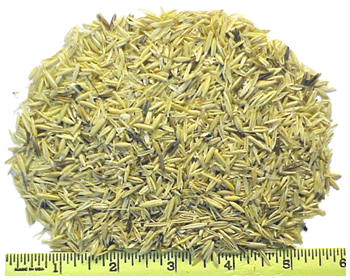
- By-product of the wheat flour milling industry.
- Consists of the coarse outer covering of the wheat kernel.
- Rich in niacin, vitamin B1, phosphorus, and iron.
- Used to provide bulk to diets and as a mild laxative.
- Used primarily in diets for horses and in diets for gestating cows, sheep, and swine.
Average Nutrient Content
- Ruminant TDN = 62%
- Monogastric ME = 1055 Kcal/lb
- Crude Fiber = 10%
- Crude Protein = 16%
Physical Description - light brown color with spots of white, fairly large particle size, and a flaky texture.
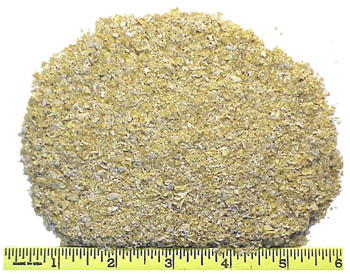
- By-product of the wheat flour milling industry.
- Consists of the fine particles of wheat bran, wheat shorts, wheat germ, wheat flour, and some of the offal from the "tail of the mill".
- Rich in niacin, vitamin B1, phosphorus, and iron.
- A palatable feedstuff commonly added to cattle diets.
- Has a mild laxative effect
Average Nutrient Content
- Ruminant TDN = 81%
Monogastric ME = 1000 Kcal/lb
Crude Fiber = 8.5%
Crude Protein =15%
Physical Description - light brownish color, small particle size, and a lightly flaky to finely ground texture.
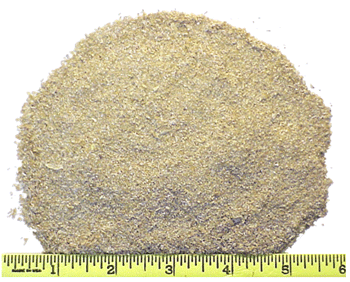
- By-product of the distillers industry.
- Consists of the dried, screened coarse grain fraction that remains after the removal of the alcohol from a yeast fermented mash.
- Primarily used as a protein and energy source in ruminant and horse feeds, but may be fed in limited amounts to monogastrics.
Average Nutrient Content
- Ruminant TDN = 79%
- Monogastric ME = 1450 Kcal/lb
- Crude Fiber = 13%
- Crude Protein = 27%
Physical Description - light to dark brown color, coarse particle size, and a flaky to powdery texture.
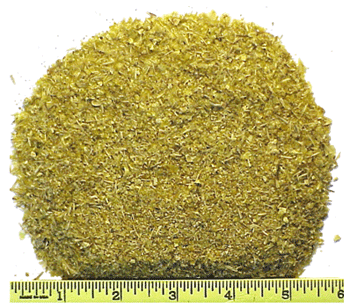
- By-product of the distillers industry.
- Obtained by drying and blending together both the screened, coarse grain fraction and the condensed screened stillage remaining after the removal of the alcohol from a yeast fermented mash.
- Primarily used as a protein and energy source in ruminant and horse feeds, but may be fed in limited amounts to monogastrics.
Average Nutrient Content
- Ruminant TDN = 82%
- Monogastric ME = 1500 Kcal/lb
- Crude Fiber = 8.5%
- Crude Protein =27%
Physical Description - lisght to dark brown color, varyihng particle size, and a flaky to powdery texture.
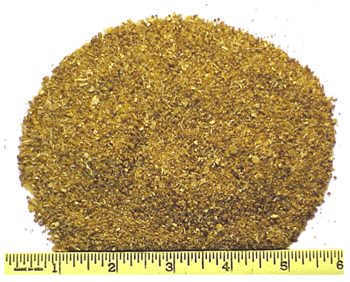
- By-product of the wet corn milling industry.
- Consists of the dried residue remaining after the removal of most of the starch, gluten, and germ from corn.
- Contains corn bran and soluble protein.
- Primarily fed to ruminants as a source of protein and energy (high fiber content limits its use in monogastrics).
Average Nutrient Content
- Ruminant TDN = 75%
- Monogastric ME = 1050 Kcal/lb
- Crude Fiber = 10%
- Crude Protein = 21%
Physical Description - brown color with a flaky to powdery texture.
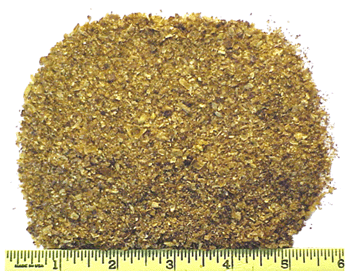
- By-product of the wet corn milling industry.
- Consists of the dried residue remaining after the removal of most of the starch, germ, and bran from corn.
- Marketed as a 41 or 60% crude protein feed ingredient.
- Primarily fed to poultry and dairy as a protein source, and is a good ruman bypass feed.
Average Nutrient Content
- Ruminant TDN = 76-86%
- Monogastric ME = 1400 Kcal/lb
- Crude Fiber = 2.5-4.0%
- Crude Protein = 41 or 60%
Physical Description - yellowish brown color with a granular to powdery texture.
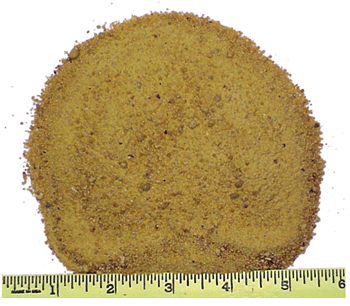
Miscellaneous By-Products
- Produced by extracting the sugar from sugar beets and drying the remaining pulp.
- Good source of digestible fiber for ruminants and horses.
- Sometimes added to sow diets to prevent constipation.
Average Nutrient Content
- Ruminant TDN = 68%
- Monogastric ME = 1050 Kcal/lb
- Crude Fiber = 21%
- Crude Protein = 8%
Physical Description - grayish-brown color, irregular particle size, and a rough texture.
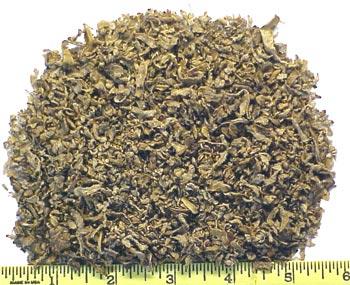
- By-product of the cottonseed oil manufacturing industry.
- Consists of the outer covering of the cottonseed that is removed prior to oil extraction.
- A high fiber, palatable feedstuff used as a roughage for cattle, especially in areas where good quality forages are scarce.
- Occasionally added in grain mixes to increase the bulk density and crude fiber content.
Average Nutrient Content
- Ruminant TDN = 47%
Monogastric ME = N/A
Crude Fiber = 43%
Crude Protein =4%
Physical Description - white colored cotton fibers and brown to brownish-black colored hulls, and a mixed rough and fuzzy texture.
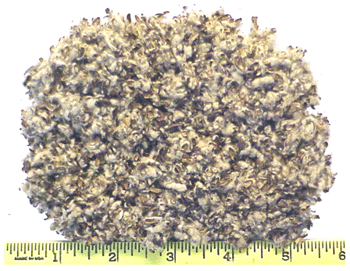
- By-product of the soybean oil and meal manufacturing industry.
- Consists of the outer covering of the soybean that is removed prior to oil extraction.
- A palatable source of digestible fiber for ruminants and horses.
Average Nutrient Content
- Ruminant TDN = 71%
- Monogastric ME = N/A
- Crude Fiber = 36%
- Crude Protein = 10%
Physical Description - light brown color with dark specks, and a flaky texture.
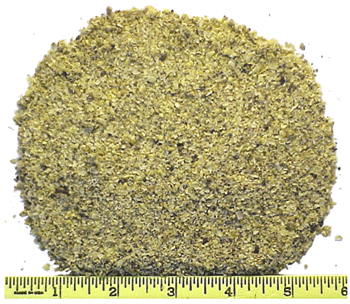
Mineral & Vitamin Sources
- A natural source of calcium and phosphorus.
- Derived from rock phosphates that have been heated to drive off fluorine.
- Must have less than 1 part fluorine to 100 parts phosphorus
Average Nutrient Content
- Calcium = 33%
- Phosphorus = 18%
Physical Description - dark gray color, small gravel shape, and a granular to powdery texture.
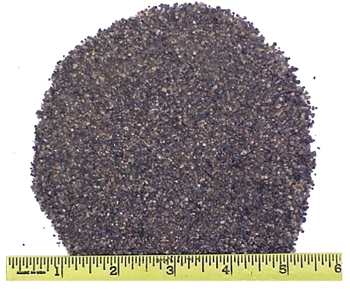
- A synthetic source of calcium and phosphorus.
- Obtained by processing rock phosphates into phosphoric acid, which is then reacted with calcium carbonate (limestone).
- Commonly used source of calcium and phosphorus in livestock, horse, and poultry feeds.
Average Nutrient Content
- Calcium = 22%
- Phosphorus = 18.5%
Physical Description - gray color, small rock-like shape of varying size, and a granular texture.
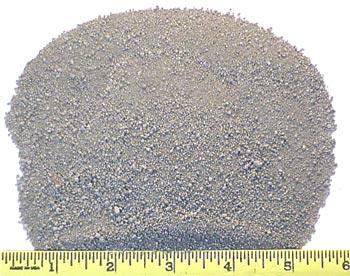
- A natural source of calcium.
- Obtained by grinding mined, calcitic limestones.
- Also called calcium carbonate.
- A relatively inexpensive source of calcium used in livestock, horse, and poultry diets.
Average Nutrient Content
- Calcium = 38%
Physical Description - light gray color and a granular to floury texture.

- A by-product source of calcium and phosphorus.
- Prepared from bones by cooking with steam under pressure, grinding, and drying.
- An excellent source of calcium and phosphorus in livestock, horse, and poultry feeds.
- More expensive than other calcium and phosphorus sources.
Average Nutrient Content
- Calcium = 24%
- Phosphorus = 12%
Physical Description - off-white to light gray color and a powdery texture.
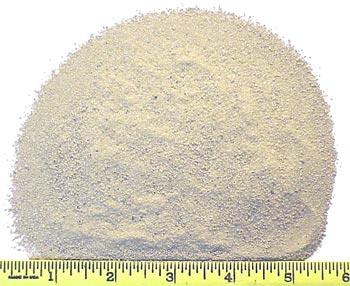
- Produced by coarsely grinding oyster shells (sometimes finely ground to produce oyster flour).
- Consists of approximately 94% calcium carbonate.
- An excellent source of calcium used primarily in poultry feeds.
Average Nutrient Content
- Calcium = 38%
Physical Description - off-white to gray color, rock-like shape, and a coarse texture.
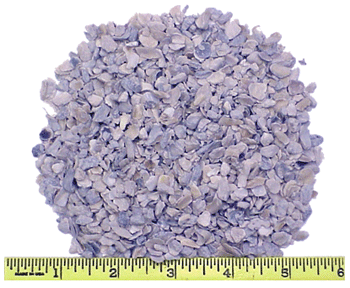
- Also referred to as bluestone.
- Source of copper for mineral supplements added to livestock, horse, and poultry feeds.
- Also included at high levels (250 ppm) in swine diets where it acts as a growth promotant.
Average Nutrient Content
- Copper = 25.4%
- Sulfur = 12.8%
Physical Description - light blue color, a tiny crystal shape, and a granular to grainy texture.
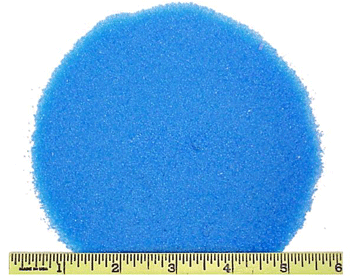
- Comprised of almost pure sodium chloride.
- Most common mineral supplement added to livestock, horse, and poultry feeds.
- May be provided in block, granulated, or rock form.
Average Nutrient Content
- Sodium = 39.5%
- Chloride = 59%
Physical Description - white color, a tiny uniform crystal shape, and a granular to grainy texture.
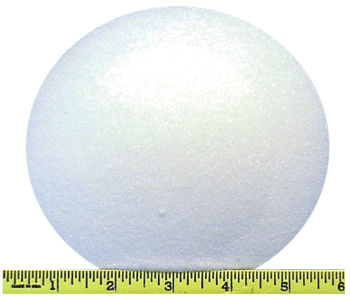
- Consists of salt and one or more trace minerals (such as cobalt, copper, iodine, iron, manganese, sulfur, selenium and zinc).
- Commonly fed free-choice to grazing animals in either loose or block form.
Average Nutrient Content
- Vaies depending on added trace minerals.
Physical Description - bronze to reddish color, a tiny uniform crystal shape, and a granular to grainy texture.
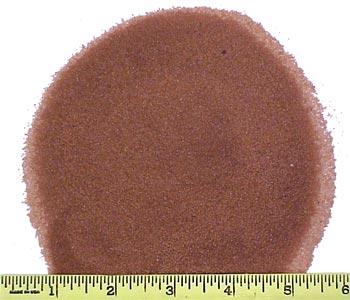
- May contain the trace minerals cobalt, copper, iodine, iron, manganese, magnesium, potassium, sulfur, selenium, and (or) zinc.
- Various inert products or feedstuffs (such as calcium carbonate, soy flour, protein meals, or rice hulls) are used as carriers in trace mineral premixes.
Average Nutrient Content
- Varies depending on added trace minerals.
Physical Description - light brown color and a flaky to very fine, powdery texture.
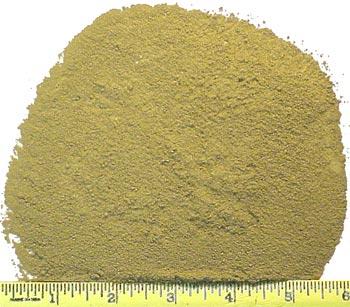
- May contain both fat soluble and water soluble vitamins.
- Fat soluble vitamins are vitamin A, vitamin D, vitamin E, and vitamin K.
- Water soluble vitamins are biotin, choline, folic acid, niacin, pyridoxin (vitam B6), pantothenic acid, riboflavin (vitamin B2), thiamine (vitamin B1), vitamin B12 and vitamin C.
- Various feedstuffs (such as rice hulls, soybean meal, corn gluten meal, and wheat middlings) are used as carriers in vitamin premixes.
Average Nutrient Content
- Varies depending on added vitamins
Physical Description - light brown to yellowish brown color, small particle size, and a flaky to powdery texture.
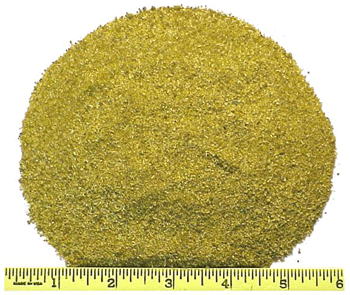
Miscellaneous Feedstuffs
- A source of nitrogen (not a protein supplement) also referred to as non-protein nitrogen.
- Should only be fed to ruminants.
- Can be toxic if fed at excessive levels (should provide no more than 1/3 of the total nitrogen in the diet).
- Diets with added urea should also contain a readily available source of carbon (energy).
Average Nutrient Content
- Nitrogen = 42-45%
Physical Description - white color, small beadlike particles, and a granular texture.
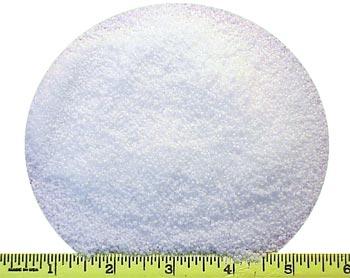
- A very potent energy source supplying about 2.25 times more energy than starch or sugar.
- Used primarily to increase the caloric density of the diet.
- Increases diet palatability.
- Sometimes added to diets to reduce dustiness.
Average Nutrient Content
- Ruminant TDN = 175%
- Monogastric ME = 3300 Kcal/lb
Physical Description - a somewhat viscous liquid with a light yellow to yellowish-brown color.
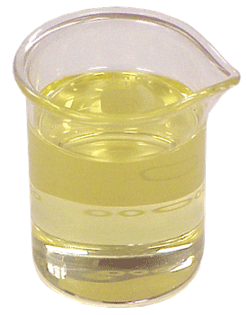
- Synthetic source of the amino acid lysine.
- Produced by bacterial fermentation.
- Used primarily in monogastric diets (especially swine diets) to lower total crude protein and meet the lysine requirements.
Average Nutrient Content
- Lysine = 78%
Physical Description - off-white to cream color and a granular to powdery texture.
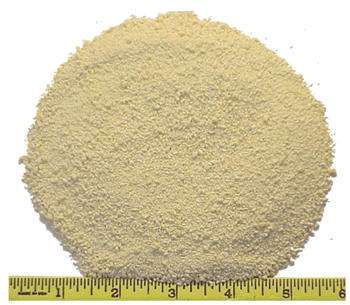
- Synthetic source of the amino acid methionine.
- Produced by bacterial fermentation.
- Used prmarily in monogastric diets (especially poultry diets) to lower total crude protein and meet the methionine requirements.
Average Nutrient Content
- Methioine = 99%
Physical Description - white color and a crystalline to powdery texture.
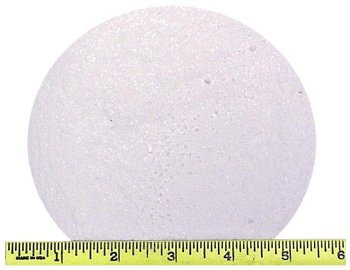
- Synthetic source of the amino acid threonine.
- Produced by bacterial fermentation.
- Used primarily in monogastric diets to lower total crude protein and meet the threonline requirement.
Average Nutrient Content
- Threonine = 98%
Physical Description - tan to light brown color and a granular to powdery texture.
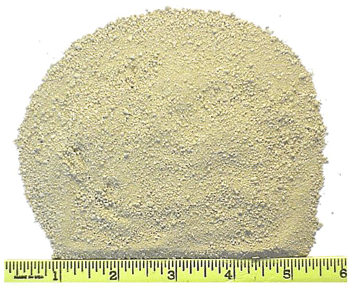
- Synthetic source of the amino acid tryptophan.
- Produced by bacterial fermentation.
- Used primarily in monogastric diets to lower total crude protein and meet the tryptophan requirements.
Average Nutrient Content
- Tryptophan = 98%
Physical Description - white to creamy color and a powdery texture.
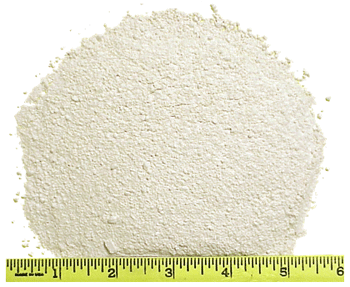
- Synthetic source of the amino acid tryptophan and lysine.
- Produced by bacterial fermentation.
- Used primarily in monogastric diets to lower total crude protein and meet the tryptophan and lysine requirement
Average Nutrient Content
- Tryptophan = 16.1%
- Lysine = 56.3%
Physical Description - light brown color and a granular to powdery texture.
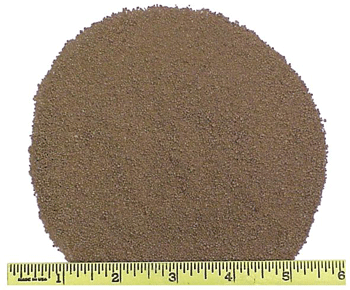
- An antioxidant (feed preservative).
- Included in diets with added fat (or diets with high fat ingredients) to retard the oxidative destruction of nutrients.
Average Nutrient Content
- No nutritive value
Physical Description - black color, small bead-like shape, and a granular texture.
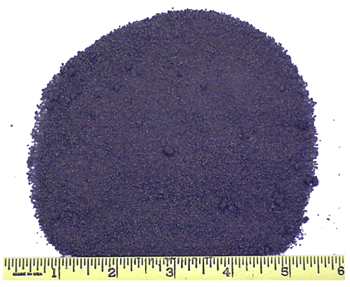
- Dried by-product of the manufacture of sugar from either sugar beets, or more commonly, sugarcane.
- Highly palatable, readily available source of energy.
- Most commonly added to ruminant and horse diets.
Average Nutrient Content
- Ruminant TDN = 80%
- Crude Protein = 7%
Physical Description - dark brown color and a flaky and (or) granular texture.
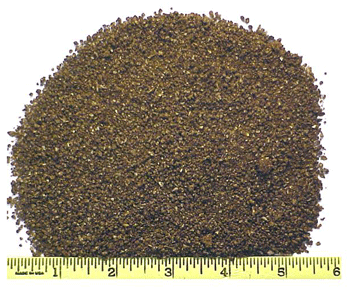
- Liquid by-product of the manufacture of sugar from either sugar beets, or mor commonly, sugarcane.
- Highly palatable, readily available source of energy.
- Most commonly added to ruminant and horse diets.
Average Nutrient Content
- Ruminant TDN = 80%
- Crude Protein = 7%
Physical Description - A viscous (thick) liquid with a dark brown to black color.
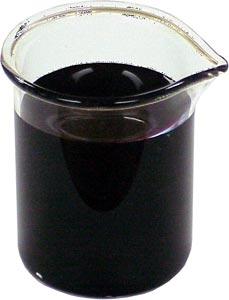
Pasture & Hay Forages
- High quality, cool season perennial legume with an extensive root system that makes it drought resistant.
- Can grow to heights of 2 to 3 feet.
- Grows best in hot, dry climates in soils that are deep, fertile, and well drained.
- As a pasture forage it is not very tolerant to continuous grazing ruminants.
- As hay it is very palatable, high in protein, and excellent for general feeding puroses.
- Annual yields = 3-6 tons DM/acre
Average Nutrient Content
- Ruminant TDN = 55-60%
- Crude Protein = 15-25%
Physical Description - erect growing with many leafy stems arising from large crowns at solid surface; compound leaves with three long, narrow leaflets, no prominent watermark or V-shaped pattern, and serrated only at tip; can have purple or yellow flowers.
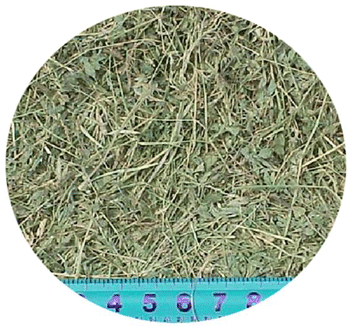
- High quality, highly palatable, cool season perennial grass with rhizomes that produce a dense sode.
- Can grow to heights of 1 to 3 feet in seed head stage.
- Can withstand close, heavy grazing better than most other grasses.
- Very sensitive to heat and summer drought (becomes dormant and brown during hot, dry summers).
- Not widely used as a hay grass because of its low yield, and if mixed with other grasses and legumes it matures before other plants are ready to cut.
- Annual yield = 1-3 tons DM/acre
Average Nutrient Content
- Ruminant TDN = 60-75%
- Crude Protein = 12-17%
Physical Description - leaves are dark green color, narrow and fine bladed with tips shaped like a boats bow; no auricles and low ligule; seed heads smaller than those for fall fescue.
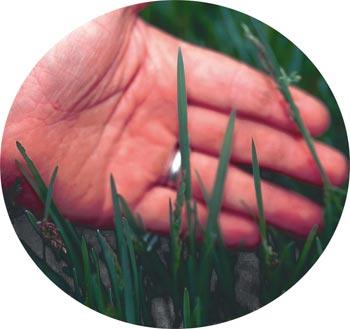
- Deeply rooted, strongly tuffed, cool season perennial bunchgrass with short rhizomes.
- Can grow to heights of 2 to 4 feet in seed head stage.
- Tolerant of soil acidity, low fertility, and poor drainage, and relatively tolerant of drought and overgrazing.
- Susceptible to endophyte fungus infection which aids in plant survival, but reduces animal performance.
- Most widely used for pasture especially winter grazing.
- Annual yields = 2-4 tons DM/acre
Average Nutrient Content
- Ruminant TDN - 45-60%
- Crude Protein = 10-15%
Physical Description - leaves are shiny, dark green, thick, wide, and ribbed with prominent veins and no obvious ligule; emerging leaves are rolled in the bud.
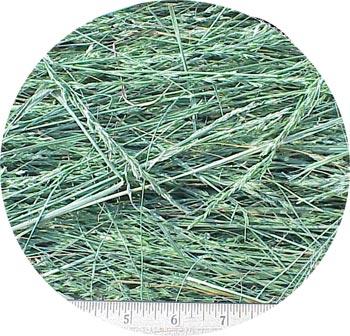
- Long-lived perennial bunchgrass that forms dense circular bunches.
- Can grow to heights of 2 to 4 feet in seed head stage.
- High quality, high yielding, palatable forage that is well-suited for use in mixtures with Alfalfa and Red Clover.
- Shade tolerant, moderately heat and cold resistant, but not tolerant of close cutting or continuous grazing.
- Annual yields = 2-4 tons DM/acre
Average Nutrient Content
- Ruminant TDN = 55-70%
- Crude Protein = 8-12%
Physical Description - bluish color leaves with leav veins less prominent than those for tall fescue; stems are flattened at base; leaves emerge along the midrib of the leaf folded in half.
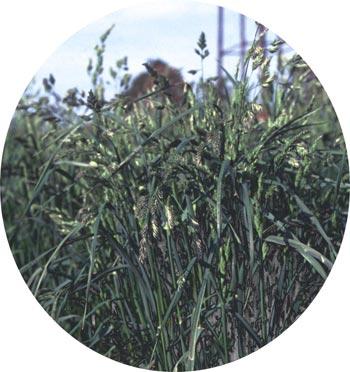
- Perennial bunchgrass with a fairly shallow and fibrous root system.
- Can grow to heights of 2 to 5 feet in seed head stage.
- Primarily a hay plant, but can be used for pasture when part of a mixture - grows well with Alfalfa and (or) Red Clover.
- Disadvantages include a short stand life, low quality when cut late, clumpy growth habits, and sensitivity to hot temperatures.
- Annual yields = 2 - 4 tons DM/acre
Average Nutrient Content
- Ruminant TDN = 55-65%
- Crude Protein = 8-12%
Physical Description - leaves have a bluish green color; swollen, bulb-like structure at base of stem; cylindrical seed head.
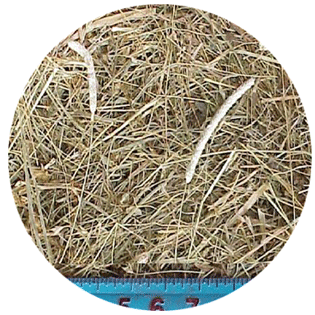
- Long-lived perennial cool season legume that spreads by stolons.
- Can grow to heights of 8 to 12 inches.
- Ladino is a taller growing type of white clover.
- Highly palatable and nutritious, it is used primarily as a pasture forage in mixtures with Kentucky Bluegrass or Tall Fescue.
- Disadvantage is the potential for bloat, especially in the spring and with thick, lush strands.
- Annual yields = 1-3 tons DM/acre
Average Nutrient Content
- Ruminant TDN = 60-70%
- Crude Protein = 15-28%
Physical Description - leafy plant with leaves that are shiny underneath and sometimes watermarked with a V-shaped pattern; stems often grooved; unlike red cover, no hairs on leaves and stems; white flowers.

- Widely adapted,high yielding, cool season perennial legume.
- Can grow to heights of 2 to 3 feet.
- Used as both a hay and pasture forage, usually in mixtures with Tall Fescue, Kentucky Bluegrass, Timothy, or other cool season grasses.
- Best suited to regions with abundant rainfall.
- Has a shorter stand life than Alfalfa or White Clover.
- Disadvantages are the hay is dusty, and over-mature cuttings contain a fungus that causes animals to slobber.
- Annual yields = 2-5 tons DM/acre
Average Nutrient Content
- Ruminant TDN = 55-70%
- Crude Protein = 12-22%
Physical Description - erect, leafy plant with large leaves that almost always have a prominent V-shaped pattern or watermark on leaflets; very hairy, fleshy stems; pink flowers.
